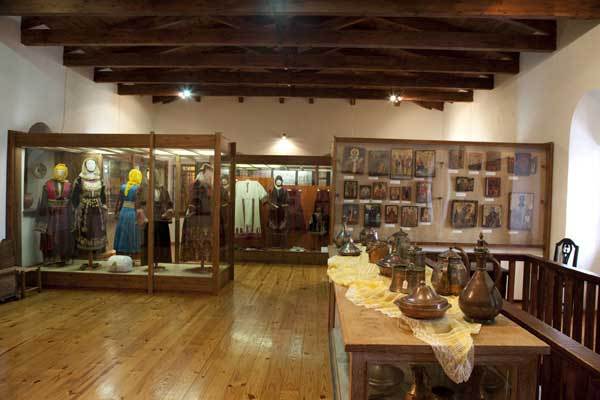The Stemnitsa Folklore Museum was founded in 1985 with the aim to promote in Greece and abroad both the folklore tradition of Greece, in general, and of Stemnitsa, in particular.The Museum’s collections evolve on two buildings. The first one, a three-storey 18th century mansion, was initially intended to be a residence and was later given to the former Municipality of Stemnitsa, in order to operate as a museum. In 1995 the second building was erected, under the initiative of Ioannis and Irene Savvopoulos, who also covered all expenses.The Museum has a great variety of collections and exhibits. The visitor will see, among other things, traditional costumes, textiles, embroideries, holy utensils and icons, representations of traditional workshops and traditional homes, as well as various items of everyday use, made with the unique local craft. Those who love traditional shadow theatre will certainly appreciate the collection of local “Karagiozis” puppeteer Lambros Karadimas.The Museum of Folk Art in Stemnitsa was established in 1985 at the initiative and the expense of Ioannis and Irene Savvopoulos. Ioannis Savvopoulos was born in Stemnitsa and had a special bond with his birthplace; a feeling he passed on to his wife. The museum a non-profit institution, which functions under the umbrella of the Ministry of Culture, and it belongs to the Greek Section of the International Council of Museums. The main objective of the Museum is the preservation of Greece’s folk heritage and its promotion within the country, as well as abroad.The museum is housed in two buildings. A three-storey 18th century building that belonged to Georgios Hatzis, and a newer one, built in 1995 by traditional standards, again at the expense of its founders, as well as of Panagiotis Aggelopoulos and Ioannis Martinos.
At the Museum of Folk Art in Stemnitsa, visitors will have the chance to see unique exhibits, as well as remarkable collections. In the old wing on the ground floor, there is a reenactment of various workshops of traditional professions, like the shoemaker, the candlemaker, the tinker, the silversmith, etc. On the mezzanine there is a reenactment of traditional local houses, with authentic artifacts and furniture, while the first floor houses a big collection, donated by Ioannis and Irene Savvopoulos, which includes embroideries, weavings, traditional costumes, ecclesiastical utensils, ceramics, wood carvings and many more. On the ground floor, in the new wing, there is a lecture hall with the capacity to host presentations and speeches, while there are also displays with interesting exhibits. Finally, on the first floor there is an interesting collection of figures of the famous puppeteer Lambros Karadimas -don.
 English
English Ελληνικα
Ελληνικα 
